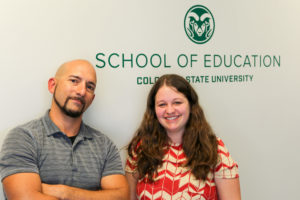Story by Samantha Ye
 For students of color, training to become future teachers can mean struggling to fit into a largely unvarying workforce. In recognition of those challenges, the Teachers of Color and Indigenous Teachers (ToCIT) Collective at Colorado State University provides a space where students can form supportive connections and unpack their experiences to ultimately sustain their passion for teaching.
For students of color, training to become future teachers can mean struggling to fit into a largely unvarying workforce. In recognition of those challenges, the Teachers of Color and Indigenous Teachers (ToCIT) Collective at Colorado State University provides a space where students can form supportive connections and unpack their experiences to ultimately sustain their passion for teaching.
The ToCIT Collective is an initiative managed by Race and Intersectional Studies in Educational Equity Center scholars Ricki Ginsberg, assistant professor of English education in the Department of English, and Vincent Basile, assistant professor of STEM education in the School of Education, in partnership with the Center for Educator Preparation.
Connection and support
The ToCIT Collective aims to serve as a support system for students of color and Indigenous students who are preparing to or wanting to become PK-12 teachers.
“We recognize through our and others’ experiences that the teaching workforce is itself a very homogeneous group right now,” said Basile. “So consequently, it makes it hard for individuals who don’t fit that mold to find a sense of support or camaraderie.”
By making formal and informal spaces for students of color and Indigenous students, the program aims to connect students to others with shared cultural or classroom experiences. When faced with negative experiences such as microaggressions, students are able to channel the support of others instead of dealing with these issues in isolation.
“Students have expressed a very positive sentiment about being heard and having a collective voice and also having a place and space to bring outside-of-the-box thinking,” said Basile.
As the initiative grows, students can find support not only in each other but in informal faculty mentorships arranged by Ginsberg and Basile.
“These support systems are aimed at increasing student sustainability as they begin the teacher preparation program, take classes and practicum, and enter into the workforce,” said Ginsberg. “It’s about building connections to help them feel like they have a home here and that there are people who understand and/or share their lived experiences.”
Strong foundation and solid future
So far, the ToCIT Collective has engaged with 25 to 35 CSU students of color and Indigenous students.
Program participation is fluid, which allows students to choose their preferred degree of participation. The goal is not a “one-size-fits-all” program but a collective which meets the varying needs of students and their teaching concentrations.
Now in its second year, the initiative is growing and evolving; additional elements are in the early working stages.
In cooperation with CEP, the initiative has established a first cohort of students to begin student teaching together next semester, which they hope to repeat regularly in future semesters. They also plan to increase the frequency of ToCIT meetings on campus.
In their first year, the collective brought a group of students to the Teachers of Color and Allies Summit in Boulder, which they plan on doing again this year.
“There are many initiatives occurring that we define as central to the program that we’re building,” said Ginsberg. “We have many ideas that we are looking forward to implementing over the coming years.”
The program has garnered support and funding from the RISE Center, CEP, and the Department of English.
Students who wish to participate in the program can contact Ricki Ginsberg or Vincent Basile for more information.
The Race and Intersectional Studies in Educational Equity Center is housed in the School of Education, part of CSU’s College of Health and Human Sciences. RISE aims to advance intersectional racial justice and equity in educational institutions’ dialogues, and collaboration between researchers, practitioners, and community stakeholders.